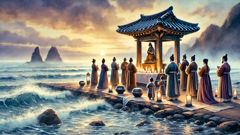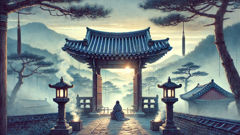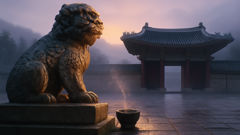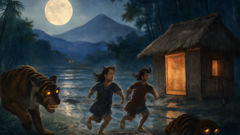Introduction
Long before maps traced coastlines or human voices named rivers, the world lay in a hush of unshaped things: a wide, breathing dark where water folded upon water and the sky hung low like a lid. From that shapeless sleep rose a presence whose name the winds learned first—Cheonjiwang, the Sky King—whose thought was as wide as the horizon and whose voice could part the silence. He did not arrive like a conqueror but like an architect, feeling the world’s raw edges with a steady hand. Stones that had waited for an order took their places as mountains; currents that had wandered met a shore and paused; a single great island tilted out of the sea, its ridges and hollows smoothed by the patient attention of someone who knew that life needs pattern to flourish.
On Jeju’s pale beaches, where basalt and sand still remembered the first shaping, Cheonjiwang laid out the rules that would bind the sky to the land and limit the wildness between. He appointed thresholds—seasons, tides, the bright clock of sun and moon—so that things might recognize each other and be known. But rules require keepers. From this need rose the first human shapes and the first royal pair, chosen not by blood but by charge: to respect the balance between mountain and sea, to steward the living chorus of wind, bird, and root. In the grooves of old stones and in the low songs of island shamans, the story of their making was preserved. This is a retelling of that making—an exploration of how order grew from chaos, how a sky king became the ancestor of law, and how an island learned to hold both tempest and calm.
Birth of Sky and Sea: The Hand That Shaped the Island
When the world was a single, slow inhale of water and dark, names did not yet exist. A hush lay over everything; stones and currents moved, but not with the purpose of a story. Cheonjiwang’s arrival was like the first exhale that brings light—silent in its beginning, inevitable in its shape. He came as a presence that knew how to separate without violence: the sky lifted from the sea as if someone had carefully peeled an immense sheet; rain and mist were given boundaries and promise. Imagine, if you will, a vast bowl of ink; into that bowl a single clear hand reaches, and where it moves a corridor of light opens. That is how the island found itself made—by attention, by the insistence that the formless could hold form.

At the heart of creation there was a conversation between elements. Wind and rock argued softly, tides and basalt negotiated in the language of time. Cheonjiwang coaxed a mountain to rise where water had been, and the mountain answered by catching cloud and sending streams into new mouths. Lava cooled into stepped cliffs; the cliffs wore hollows that caught rain; rain found paths and became rivers. Seasons were first a pattern traced in the margins: a warm pulse, a cool sigh, the slow turning of leaves and kelp. The Sky King did not simply decree order from above; he taught it to the world by example, showing how one thing depended on another, how gulls would follow currents where fish were fed, how roots would search for the small pockets of soil that collected on ancient rock.
There is an old island logic in the tale: everything touches everything, and the edges are where stories are born. The island’s edges—its rocky skirts and sandy mouths—became thresholds. On these thresholds, where salt met fresh, Cheonjiwang put down his first signs. He set a rule that tides should not swallow forests, that storms should have a measure, that the bright eye of the moon should pull the sea but leave the springs undisturbed. It is a curious thing about rules: they are not only boundaries but gifts. By naming the rhythm of things, Cheonjiwang made a place where life could predict its day and find its neighbors. Predictability allowed nurturance; nurturance allowed the soft arrivals of birds and human hands.
From the island’s first pools rose the tentative shapes of life that would dwell there. Not in an instant, not in a burst, but in a long arranging—lichen on stone, sprig of grass claiming a crack, seaweed threading the foam. Creatures that today we call ordinary were then signs of the island’s patience. Cheonjiwang watched this patient assembly like a potter turning clay. He gathered the pattern of tides, the measure of storms, the slope of slopes, and from that pattern he folded a plan for rulers—someone to speak those rules aloud when the king’s presence was not visible. The first rulers, in the telling, were not arrogant monarchs but stewards given a job: to keep watch over thresholds, to speak for the balance between harvest and healing, to perform the rites that kept the currents in their promised courses.
Stories survive where people need them. On Jeju, songs and bon-puri performances caught the outline of Cheonjiwang’s shaping and repeated it, so that each generation might say what had been given. In the bon-puri, the Sky King becomes at once maker and judge, lax in no mercy but careful in no cruelty. He is the kind of sovereign whose authority rests on making possible rather than on taking. Such a sovereign demands humility from those who serve: to be a ruler is first to be a keeper, and to be a keeper is to understand that one's existence is entangled with the soil beneath the feet.
The island, after Cheonjiwang’s work, did not become a static museum piece. The rules allowed room for storms, for lovers, for seasons of scarcity and abundance. They allowed people to build huts along sheltered bays and to dig wells where fresh water pooled behind lava ridges. The Sky King left marks that were both practical and ritual: stones placed to mark the turning of the year, small shrines on ridgelines facing the east, chants and offerings named for the first breath of sea and sky. Each act of building was, in a sense, a covenant with the balance that Cheonjiwang had named. People learned which kelp made good fertilizer and which waves would carry ships, which winds would rip sails and which would swell them gently toward harbor. Knowledge, the story insists, is a kind of worship; to know the land is to honor it.
There are places on Jeju where old people will point at a rock and say, with a laugh, that the Sky King once rested there. Whether or not such a rest truly occurred matters less than the way the memory holds a community together. In every telling someone learns how to read the sky—when mist is a promise of rain, when a certain flock’s pattern means the tide will change sooner than the calendar suggests. The myth of Cheonjiwang becomes a manual, lyric and practical, stitched into lullabies and harvest songs. It is by this stitching that an island can both be small in acreage and vast in the web of obligations its people carry.
Looking back through the centuries, the language of the myth also records a moral imagination: that power is accountable to the balance it maintains. Cheonjiwang’s rule is not a stern decree from aloofness but a curriculum of stewardship. He expects the first rulers to learn the measures of generosity and restraint. He teaches that abundance without care becomes famine and that a closed heart to the sea invites loneliness. The Sky King becomes, therefore, a teacher whose lessons are given in wind and tide and the patient shaping of stone. In the long arc from void to island, the myth tells us how a place becomes home: by the deliberate work of naming relations and appointing keepers.
In the retelling of the birth of sky and sea, one hears also the quiet insistence that the world is not a thing to be taken but a story to be continued. Cheonjiwang’s gift was a narrative frame in which living beings could locate themselves and each other. By building thresholds, he made gatherings—of fish and fisher, of bird and watcher, of human and harvest. It was there, at those meetings, that the island's voice learned to sing. The first songs were not mere entertainment; they were a means to remember where to stand and how to act. And in remembering, the island’s people sustained the balance, generation by generation, in tide and hearth and festival.
The First Rulers and the Law of Order: Rituals, Responsibility, and Roots
Cheonjiwang set the world by measure and then turned to the problem of continuance: how would the order be recognized and kept when his hands were not visible? Out of that question came the first rulers—figures chosen by the Sky King to hold the pattern he had drawn and to speak its language aloud to people and to beasts. The selection was not about lineage. It was about capacity: to listen to the land’s small mutterings, to interpret the sea’s temper, and to perform rites that reminded sky, stone, and tide of the covenant they shared. The rulers became mediums between the celestial law and everyday life, ensuring that the rhythms Cheonjiwang set would be honored without becoming rigid dogma.

In the earliest ceremonies, there was a simplicity that shamanic singers later made into ritual form. They stood at thresholds—where the forest thinned, where a river met the sea—and recited the pattern: tides and seasons, the months to plant and the months to gather, the days to honor the dead and the days to celebrate birth. Certain stones became markers, shimmed into the ground and washed with offerings, their faces engraved by hands that remembered the Sky King’s gestures. Those markers were maps of obligation. They told people where to place their nets so that fish could replenish; they taught which groves should never be cleared so that springs would continue to flow. These acts created a pragmatic ethics: respect what regenerates, do not take the future for the present’s greed.
The rulers’ duties were also judicial. Boundaries must be enforced with care lest inequality or envy erode the very balance that sustained life. Conflicts over the best fishing grounds, the use of shared pastures, or the timing of harvests required adjudication not by cold law but by counsel attuned to interdependence. The first rulers sat with elders and shamans, listening to the signs and to the history of each claim. They measured not merely land but relationships, and their verdicts aimed to restore the weave rather than cut threads.
Central to this governance was the performance of bon-puri—the long narrative songs and dramatised recitations that carried sacred memory. Bon-puri were not mere entertainment. They were a living constitution, performed at rites of passage: births, funerals, marriages, and the renewing of the year. In those performances, Cheonjiwang becomes a character who models the virtues required of rulers: forbearance, foresight, and humility. The audience learns, almost by osmosis, the grammar of stewardship: when to demand sacrifice for the common good and when to yield for the sake of the land’s future. The performance itself is pedagogical: repeated lines, gestures, and offerings embed the law into the bodies of listeners, so that knowing how to act becomes as natural as breathing.
The myth also encodes specific environmental wisdom. The island’s basins and ridgelines were read as texts: where a certain moss grew, a spring might be near; when a certain gull nested, the current might shift at a particular bend. The first rulers cultivated that literacy. They taught young fishermen to watch the horizon for wind-smoke and to set nets where currents spilled nutrient-rich waters. Women and elders kept knowledge of plants—what would staunch a fever, what would coax a child’s appetite back, what roots would help the soil hold on a slope. Over generations, these practices became ritualized: a particular tea at planting, a song before clearing a small plot, an offering of salt and rice to the sea. Through ritual, survival practices gained moral weight and were protected from careless alteration.
There is tenderness in the myth’s account of authority. The first rulers are not remote potentates but neighbors whose decisions are visible and whose mistakes are accountable. The Sky King, in selecting them, binds rulers to ritual and to community. He insists they partake in labors—planting beside others, mending nets, cooking for festivals—because rule, in this telling, is inseparable from service. If a ruler grew proud and neglected the small tasks that keep life whole, the myth suggests, the island would speak through broken wells and dwindling harvests. Nature has ways of testing those who hold too tightly to power; the older tales are full of quiet reversals where hubris meets the patient retaliation of sea and wind.
The mythic legal system also established ways to honor those who had gone before. Ancestors were not removed to a distant heaven but remained near in weathered objects and in the liturgies of kinship. Funerary rites were careful, precise, to keep the dead integrated into the continuing story; offerings ensured that ancestors continued to bless the fields and boats. This was a polity as much of memory as of land; to forget the ancestors’ obligations was to sever one’s place in the chain that sustained harvests and health.
Where Cheonjiwang’s initial shaping is an act of cosmic composition, the rule-making that follows is a lesson in humility. A ruler is chosen not to command nature but to listen to it and to be judged by it. The first rulers' legitimacy flowed from demonstrated fidelity to the covenant: preserving springs, ensuring fair shares, performing proper rites. Their authority was relational—never absolute—and so the governance that took shape across generations became a mosaic of small obligations honored rather than a single edict imposed.
As the myth evolved into its performance form, new layers accrued—stories of tests, of sacrificial offerings that revealed true hearts, of seasons when the sea refused to yield fish until a community mended a breach with an offering. These dramatic episodes made moral points memorable: that a community’s prosperity is bound with how those within it attend to the fragile balances that the Sky King instituted. The bon-puri performers, who counseled as much as they entertained, ensured that rulers remained answerable. In that way, the myth functions as both origin and guideline—an origin that never stops instructing and a guideline that forever reminds of origin.
Finally, look closely at the material culture left by such a myth. Stone altars, directional markers, chant books, and seasonal dances are all traces of a story that wants to be embodied. The retelling of Cheonjiwang’s appointment of rulers is not nostalgia for a lost ideal but a practical template that communities have used to navigate change. Even as boats modernize and fields adopt new methods, the core insistence of the story persists: survive by reading the land, honor the limits, and make sure the powerful serve the health of the whole. That insistence is why the myth remains alive in songs, in festivals, and in the quiet counsel passed from grandparent to child: the law of order is not a set of impositions but a living correspondence between human will and natural will, and Cheonjiwang’s legacy is the humility such correspondence requires.
Conclusion
Legends continue because they answer needs older facts cannot touch. The tale of Cheonjiwang Bonpuri endures not because it claims to be literal history but because it provides a language for living in a place where weather, tide, and rock shape human fate. The Sky King’s ordering of sky, sea, and mountain is a metaphor and a map: it invites listeners to learn measures and to become custodians rather than mere owners. In Jeju and beyond, the myth lives in the cadence of bon-puri, in stone markers, in the etiquette of offering at thresholds, and in the civil sense that authority is service. In modern times, when development presses against fragile coasts and new technologies change the relation between people and place, the ethic embedded in Cheonjiwang’s story remains urgent. It encourages an attitude of restraint, a practice of reciprocity, and the humility to know that every choice tilts the balance of the living world. To retell Cheonjiwang is to rehearse those commitments: to read the weather with patience, to judge with compassion, to govern with the care that keeps springs from failing and fisheries from collapsing. Thus the legend remains a living guide, a solemn, hopeful song that calls each generation to steward the island and the wider earth with reverence and skill.













